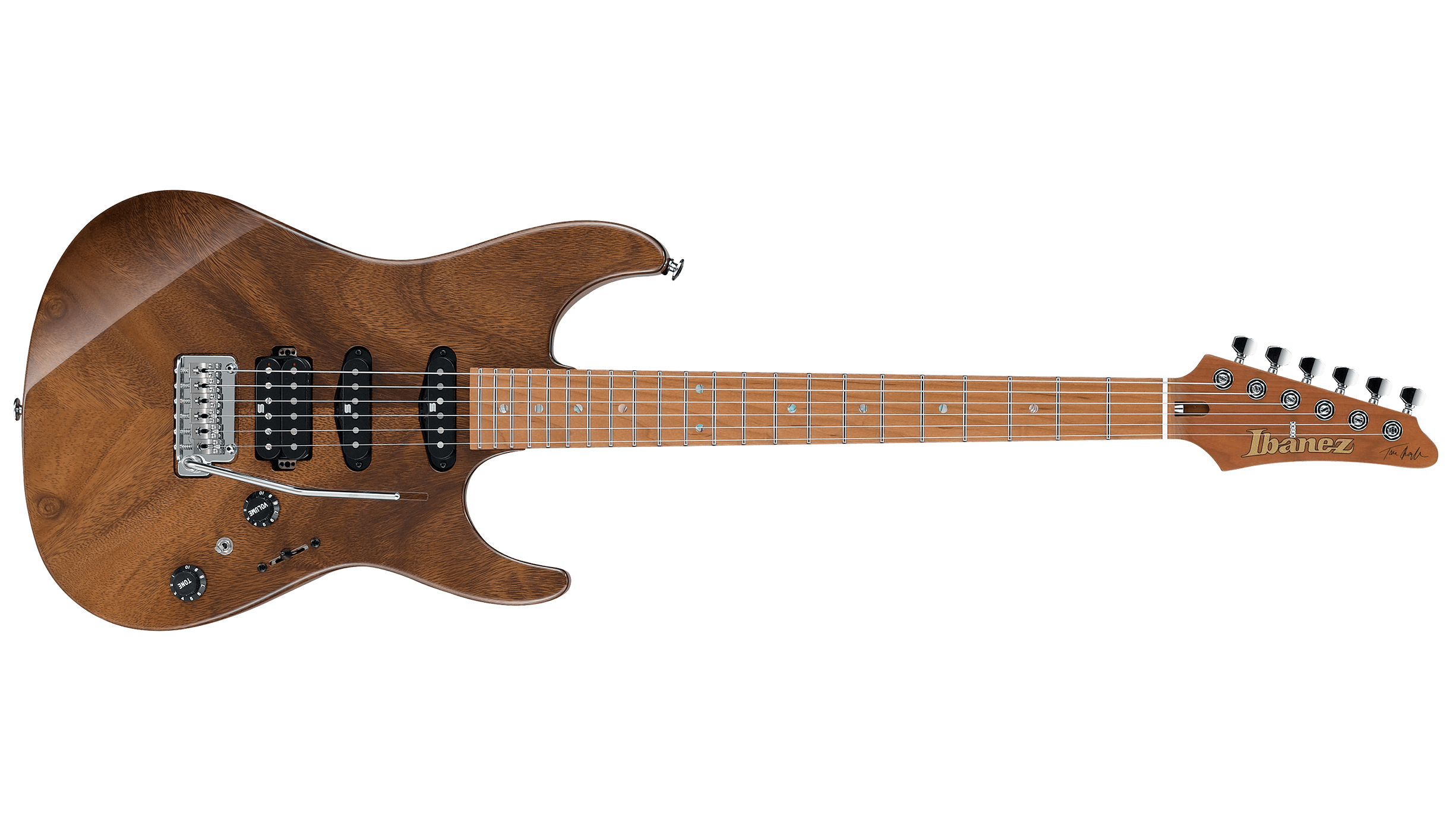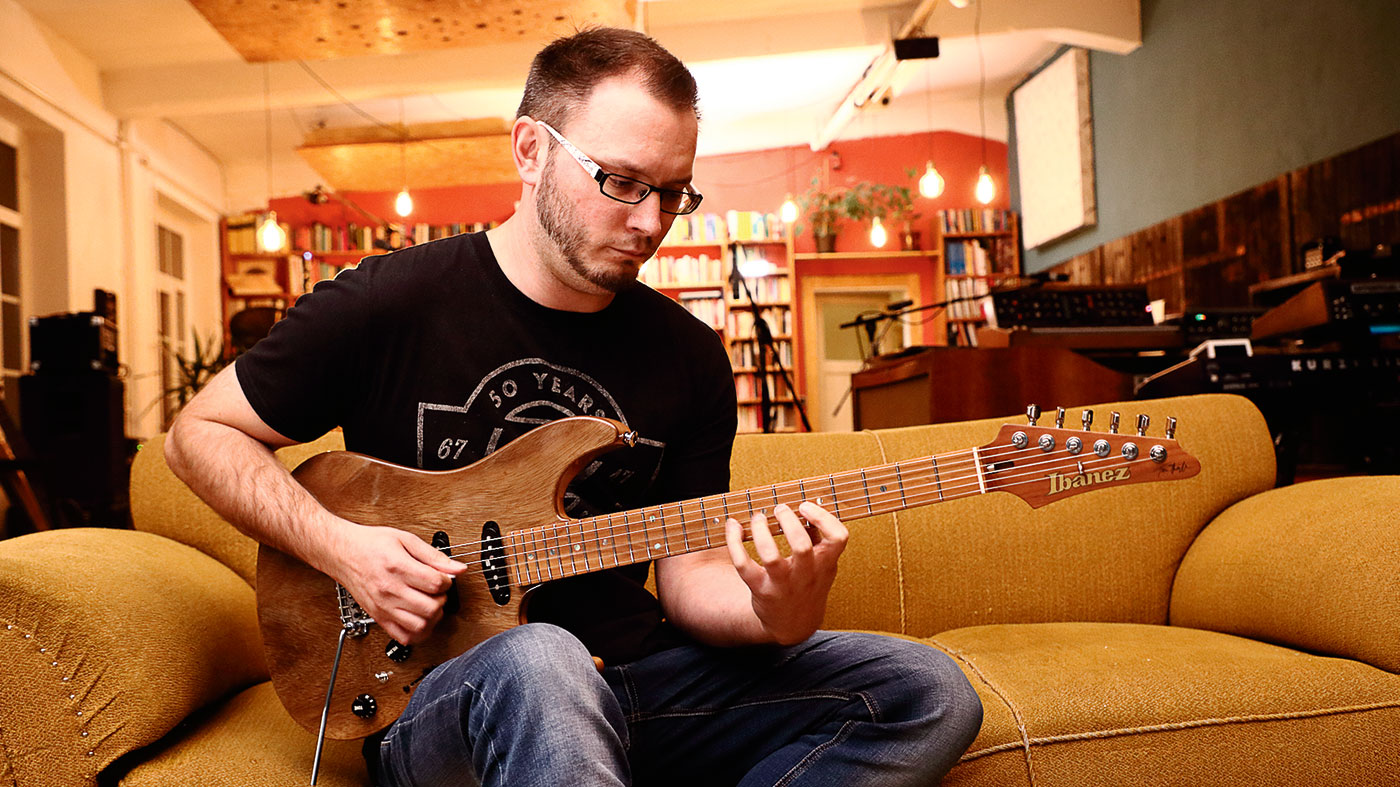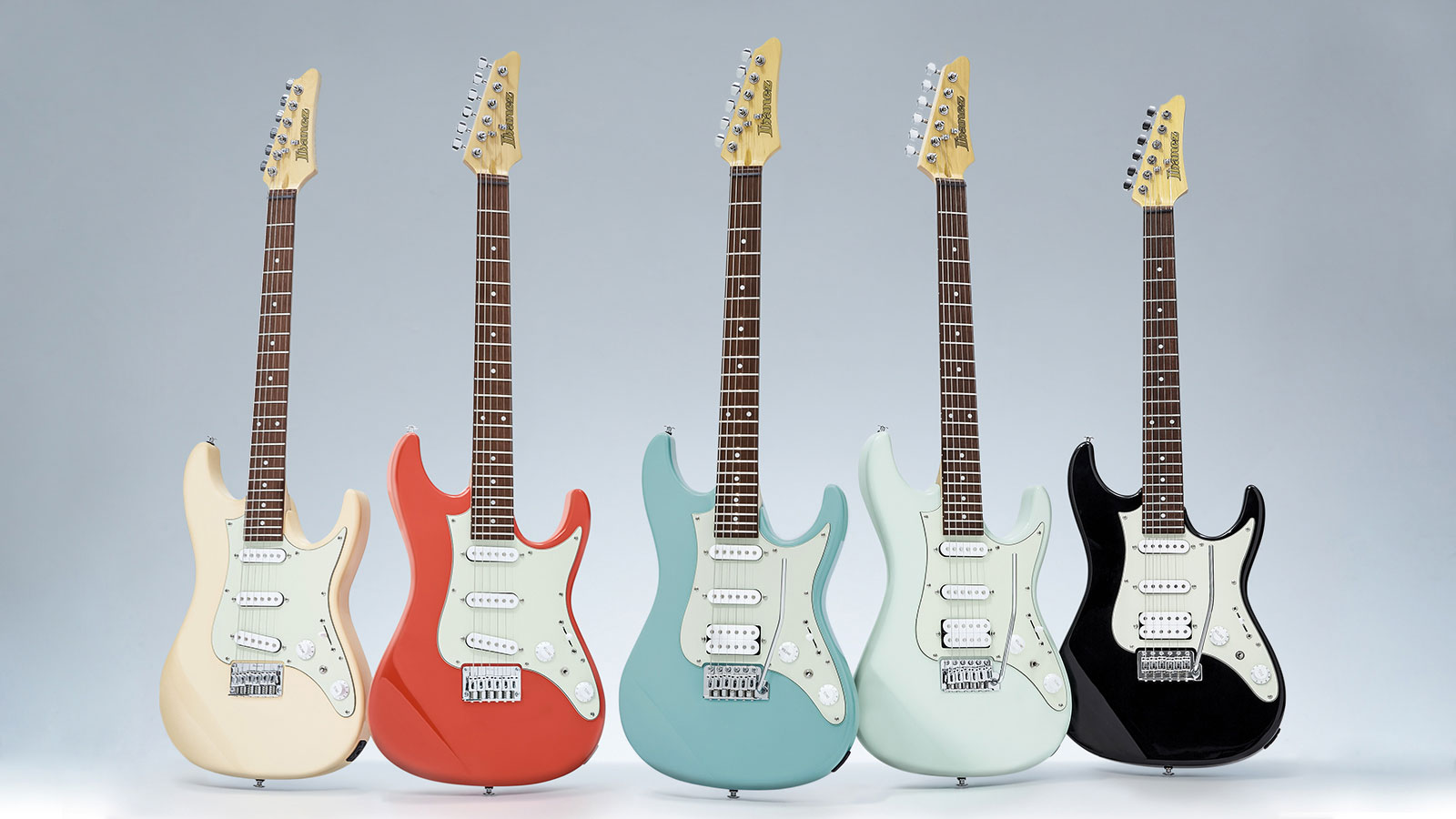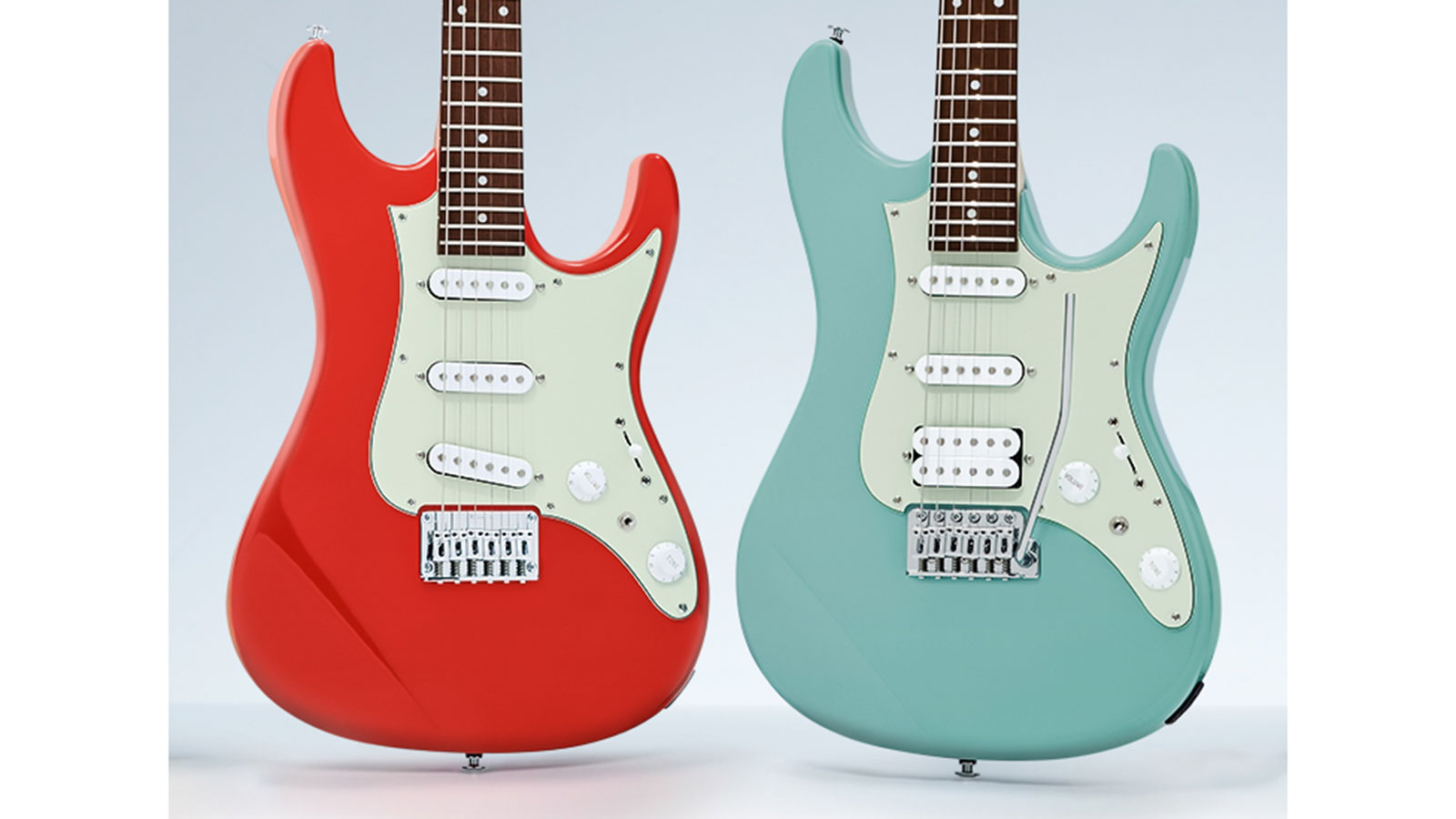Tom Quayle talks jazz fusion, Laney Lionheart and the new Ibanez AZE guitars
"This would be an amazing guitar for any player"
Guitar Showcase 2021: Tom Quayle is a bona fide wizard with an electric guitar. Sure, there is plenty of real-world evidence to attribute his progression as a top-tier player to less supernatural origin stories – we all know he studied jazz guitar and has degree in Jazz Performance. But still…
Let’s just say the wizard theory remains plausible. An early disciple of the big beasts of shred, cats such as Steve Vai and John Petrucci, Quayle has gone onto make a name for himself as a performer and teacher.
For a taste of what he can do on record, check out The Elba Triangle’s Chapter One, on which he, Marco Sfogli, and Alessandro Benvenuti rework a number of fusion classics. Or if you are looking to send your legato chops to bootcamp, or need a fresh approach to fretboard navigation seek out his instructional material, widely available on YouTube, with a comprehensive fusion guitar syllabus for purchase via his website.
No matter where you find Quayle, however, he’ll be playing his Ibanez signature guitar, the TQM1. A Japanese-made Prestige model, it is a do-everything S-style, with a monkeypod top on an alder body giving it a unique look.
In the exclusive video interview at the top of the page, Quayle shares about some of the design choices that went into the development of the guitar, and how the difference between a stock AZ series model and the TQM1 is not as great as you might think.

He also talks us through his love for Laney Lionheart amps, the expansion of six-string virtuosity across social media, and how his fretboard navigation app, Sølo, developed with David Beebee, can help aspiring fusion players.
As he explains, improvisation is dependent on our musical vocabulary; not just in expanding in, in how readily we can access it to express ourselves.
Get the MusicRadar Newsletter
Want all the hottest music and gear news, reviews, deals, features and more, direct to your inbox? Sign up here.

What is fusion guitar?
I think a lot of technical guitar playing that has got a lot more complex chordal structures in it is now deemed to be fusion
“To me, fusion has taken on a different meaning since the original meaning that I [first] associated with it. I did a jazz degree, and started in 1999, and then, fusion certainly meant a literal fusion of - obviously – multiple styles. I guess, traditionally, it was a fusion of jazz, so you would get the harmony and some of the rhythmic complexity of jazz fused with some of the energy and physicality of rock and funk, guys like Herbie Hancock, Weather Report, those kinds of bands doing what you would traditionally term ‘complex music’ with a more edgy, raw sound.
“But I think it has changed over the last decade as YouTube as come onto the scene. It has morphed into this kind of technical style of guitar playing. There is a slightly guitaristic bent to it now which is very technical guitar playing that’s got a harmonically involved sense to it but it is very much based around improvisation.
“It has kept that improvisational sense from jazz, that harmonic sense, but I think a lot of technical guitar playing that has got a lot more complex chordal structures in it is now deemed to be fusion. Whereas it was more of a jazz-based thing previously. It was more rooted in the tradition of jazz but with a rock edge.”
Improvisation
Each genre, each style will have its own vocabulary that you draw from, and it takes a lifetime of study to get to the point where you feel a level of freedom within the genre that you are playing, and I don’t think that journey ever stops
“Sometimes, people can have a misconception about improvisation as literally coming up with stuff on the spot. But, of course it is like how we are having a conversation now, where we are not thinking overtly about what we are saying, we are considering what each other is saying and subconsciously we are forming our responses to each other. But it is based on pre-existing language memes in our mind; we have sentences and grammar, and a particular vocabulary that we use, and it is the same thing with improvisation
“Whether you are playing blues, and using just a single pentatonic scale, or whether you are playing through very complex changes in a jazz context, you have to learn the vocabulary. It’s like speaking another language, and you either do that by listening, listening, listening and learning and transcribing the other phrases that musicians have used, which I guess the analogy would be immersing yourself in the language… just listen to it all the time, get the ebb and flow of the language.
“Each genre, each style will have its own vocabulary that you draw from, and it takes a lifetime of study to get to the point where you feel a level of freedom within the genre that you are playing, and I don’t think that journey ever stops. You can always learn new vocabulary, new phrases and new ways of approaching things in jazz.
“The thing with music is there are other elements, things like time and feel. There are physical elements. We don’t think too much about the physicality when we speak; it is very natural to us. When we play an instrument, there are physical things that you need to be able to pull off from a technical point of view. They come into the equation as well.”
Going Sølo with his app
It listens to what you are playing and it analyses it in real time, and it tells you if you are playing the right notes or not
“Essentially, Sølo was an app that we developed for ourselves. We came back from a guitar show in London, just before Covid hit, and we were talking about how cool it would be if there was an app that enabled us to practise in a particular way that David [Beebee] and I have discussed for a number of years now.
“It is a particular way of visualising the fretboard. It sounds very dogmatic when I put it this way, but we think it is the most efficient way to visualise the fretboard. What the app tries to do is get you to practise relating every single note that you play to the root note of a chord and a scale, by how it relates intervallically – so are you playing the 2nd? Are you playing the 3rd? Are you playing the 4th? … We have a specific way of visualising this. You are consciously taking onboard, ‘Okay, now I’m playing the 3rd of this F7 chord, now I am playing the 9th, now I am playing the 7th, now I am going to go this Bb-Maj7 chord and I can see where the 3 is, I can see where the 5 is’ , without relying on very large shapes.
“It shows you a chord and a scale and it asks you to play these intervals. We think the technology is quite clever. It listens to what you are playing and it analyses it in real time, and it tells you if you are playing the right notes or not. We have been very surprised, because we created it for ourselves, it has been really, really, successful. And we’re thankful that so many people have checked it out. It has been a huge amount of work but very rewarding and very cool.”
Why the super-affordable Ibanez AZ Essentials series is amazing

For me, this is in some ways – and this is a really weird thing to say – it is easier to play than my Prestige signature model!
“Obviously, as an Ibanez signature artist, you’re going to think, ‘Oh, of course he is going to say it’s amazing.’ Really, when this came through… I have had this guitar for a while because we needed to get the [demo] video together and find out what they needed but when it arrived, I knew it would be good because their Indonesian-made guitars are very good for the money generally, and I own some Indonesian-made Ibanez guitars here. They have some incredible guitars.
“This is remarkable for the money. It has the same switching system on it and the little things, the feel of the switch is really solid. It doesn’t feel cheap. The controls are the same. They’ve got this custom kind of jack socket on here which is really nicely designed. But fundamentally, apart from the hardware, the core things are there. It stays in tune really well. The intonation is flawless, as flawless as a guitar can be. The neck is a very similar profile.

“One thing that I really appreciate is, although I play big, stretchy legato stuff, I don’t have big hands, I don’t have long fingers. It’s something I have always been very jealous of my dad because he is an amazing fingerstyle guitar player, and unfortunately I must have inherited my finger length from my mother! I don’t have a big stretch. But this has a shorter scale length and obviously, that’s always going to be a compromise – you shorten the scale length because you want it to be more approachable for younger people, but for guitar players who are more used to playing a Strat-style scale length, as the standard AZ series has, it can be awkward; this is a really nice middle ground.
“For me, this is in some ways – and this is a really weird thing to say – it is easier to play than my Prestige signature model! Just because of that scale length. But it sounds great. Little details, the things you should get right for a beginner guitar, an intermediate guitar: there are no screws sticking up from the saddles. You’ve got the neck joint similar to the high-end AZ range. Very comfortable. Very surprising. Typical of the Indonesian guitars that I’ve played from Ibanez, the fret treatment on this, the edges of the frets are really nicely done.
“This would be an amazing guitar for any player. These are so affordable and so well made and playable, you could totally get this and mod the hell out of it and have a unique instrument that is really easy to play – and maybe have a really weird combination of pickups. Do whatever you want to it; you’re not going to break the bank and it is still going to sound great.”
For more info on Tom Quayle visit his website and to find out more about the Lionheart and AZES range visit Laney and Ibanez.
Jonathan Horsley has been writing about guitars and guitar culture since 2005, playing them since 1990, and regularly contributes to MusicRadar, Total Guitar and Guitar World. He uses Jazz III nylon picks, 10s during the week, 9s at the weekend, and shamefully still struggles with rhythm figure one of Van Halen’s Panama.
“I’m beyond excited to introduce the next evolution of the MT15”: PRS announces refresh of tube amp lineup with the all-new Archon Classic and a high-gain power-up for the Mark Tremonti lunchbox head
“These guitars travel around the world and they need to be road ready”: Jackson gives Misha Mansoor’s Juggernaut a new lick of paint, an ebony fingerboard and upgrades to stainless steel frets in signature model refresh




![PRS Archon Classic and Mark Tremonti MT 15 v2: the newly redesigned tube amps offer a host of new features and tones, with the Alter Bridge guitarist's new lunchbox head [right] featuring the Overdrive channel from his MT 100 head, and there's a half-power switch, too.](https://cdn.mos.cms.futurecdn.net/FD37q5pRLCQDhCpT8y94Zi.jpg)





